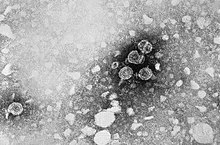Hepadnaviridae
| Hepadnaviridae | |
|---|---|
 |
|
| TEM micrograph showing hepatitis B virions | |
| Virus classification | |
| Group: | Group VII (dsDNA-RT) |
| Order: | Unassigned |
| Family: | Hepadnaviridae |
| Genera | |
Hepadnaviridae is a family of viruses. Humans, apes, and birds serve as natural hosts. There are currently seven species in this family, divided among 2 genera. Its best-known member is the Hepatitis B virus. Diseases associated with this family include: liver infections, such as hepatitis, hepatocellular carcinomas (chronic infections), and cirrhosis.
Group: dsDNA-RT
A new virus has been described in fish - White sucker hepatitis B virus. This is the first hepadnavirus described from fish. While clearly a hepadnavirus it appears only to be distantly related to the previously described genera and will almost certainly be placed in a new genus.
Several other viruses have been described from fish and from a frog: Bluegill hepadnavirus (BGHB), African cichlid hepadnavirus (ACHBV) and Tibetan frog hepadnavirus. It seems likely that new genera in this family will need to be created.
Although liver diseases transmissible among human populations were identified early in the history of medicine, the first known hepatitis with a viral etiological agent was Hepatitis A, in the picornaviridae family. Hepatis B Virus (HBV) was identified as an infection distinct from Hepatitis A through its contamination of measles, mumps, and yellow fever vaccines in the 1930s and 1940s. These vaccines contained HBV-infected human serum as a stabilizing agent. HBV was identified as a new DNA virus in the 1960s, followed a couple of decades later by the discovery of the flavivirus Hepatitis C. HBV was first identified in the lab as the "Australia agent" by Blumberg and colleagues in the blood of an Aboriginal transfusion patient. This work earned Blumberg the 1976 Nobel Prize in Medicine.
Hepadnaviruses have very small genomes of partially double-stranded, partially single stranded circular DNA. The genome consists of two strands, a longer negative-sense strand and a shorter and positive-sense strand of variable length. In the virion these strands are arranged such that the two ends of the long strand meet but are not covalently bonded together. The shorter strand overlaps this divide and is connected to the longer strand on either side of the split through a direct repeat (DR) segment that pairs the two strands together. In replication, this pds genome is converted in the host cell nucleus to covalently-closed-circular DNA (cccDNA) by the viral polymerase.
...
Wikipedia
